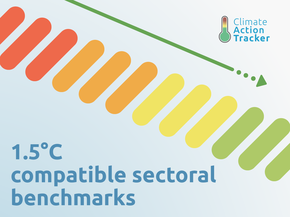Country summary
Overview
India has made significant progress in renewable energy capacity installation, ranking fourth in the world in 2022. The Indian government has implemented comprehensive policy measures to encourage renewable energy, including capacity targets, improvements to administrative processes and incentives for the domestic production of solar technologies, and ramping up the production of green hydrogen.
But reliance on coal power continues to be a drag on ambition. The government is pushing for increased domestic coal production and plans to build substantial new coal power capacities between 2027 and 2032 under the latest electricity plan. India also wants to increase its Liquefied Natural Gas (LNG) imports. Our analysis shows that with current policies, India will overachieve its NDC targets, so it could set a stronger target. The CAT’s overall rating of India’s climate targets and action remains “Highly insufficient”.
The National Electricity Plan (NEP2023), adopted in May 2023, sends mixed signals on India's climate ambitions. It includes a ramping up of renewable energy capacity and has limited additional coal power plants to 2027 to those already in the works. But it also has significantly more coal later in the decade in the final version of the NEP compared to an earlier draft (released in September 2022). Under the adopted plan, India envisages needing an additional 25.5 GW of coal capacity in the second half of the decade, a more than 150% increase on previous plans. These plans are inconsistent with a 1.5°C-compatible pathway: India needs to phase out its coal usage, not construct additional capacity.
With the falling cost of renewables and the shelving of several coal projects in recent years, it is questionable whether this capacity will actually be built. Yet, to include such an increase in coal capacity in its official plans sends the wrong message about India’s commitment to climate action.
The NEP2023 does eliminate the small amount of new gas power that had been planned for 2022-2027 along with 7.7 GW of additional coal capacity for the same period, as well as reduce the overall reliance on nuclear power throughout the decade, which are all positive developments. Total capacity added for solar has been raised by 31 GW compared to the draft version, but the plan foresees slightly less wind power (12 GW less), for an overall increase of 21 GW in non-hydro renewable energy capacity.
India has witnessed a surge in summer electricity demand in recent years due to extreme heatwaves. The country is experiencing a major heatwave in the ongoing summer months and regular power outages. In the past, India faced coal shortages during peak summer demand, resulting in substantial power outages.
To address this, the government has instructed coal and gas plants to operate at maximum capacity during the summer months. Future extreme heat events will increase even if we meet the Paris Agreement’s 1.5°C temperature target. This rise in temperature will create additional demand for electricity for cooling, further reinforcing the need to shift towards sustainable energy sources to meet the increased energy demand.
Efforts are underway to enhance domestic coal supply by increasing production in operational mines and opening up new coal mining areas as well as through imports. India also aims to become a net exporter of coal by 2026 with speedy expansion of the new mining blocks.
Some of the recent positive developments in terms of climate change mitigation policies include:
- Several measures to support the domestic solar PV industry, from the promotion of manufacturing panels and attracting private investment, to increasing the demand for domestically-produced panels.
- Policy support to expand storage capacity. The 2023-24 budget includes funds for battery storage. The Ministry of Power has also released draft guidelines for pump storage projects (PSPs). However, concern has been expressed over the environmental clearance process stated in the guidelines.
- Continuous support for green hydrogen and the National Hydrogen Energy Mission launched in January 2023. The mission aims to position India as a significant player in the global green hydrogen market, with a target of becoming an exporter of green hydrogen.
To increase its climate action, India should:
- Stop building new coal power capacity and develop a sustainable and inclusive plan for the early retirement of its existing capacity. This includes the rapid build-out of renewable electricity and storage options, to ensure seasonal peaks in the demand can be met safely.
- Avoid locking-in a dependency on LNG imports. India is planning to increase the import of LNG as international market price is stabilising. Where such imports cannot be avoided, India should ensure that the infrastructure can be decommissioned or potentially be reused, which is often difficult.
- Strengthen its climate targets. India is already on track to meet and exceed its targets. Achieving the emissions reductions needed to limit warming to 1.5°C will require much international support. India could adopt an ambitious conditional target to indicate what it would be willing to do if that support were made available.
India is set to host the G20 Summit in September 2023. Enabling just energy transitions for developing countries is one of its top priorities for the Summit. India, like many other developing nations, will need support to transition their economies to a 1.5°C compatible pathway, yet its doubling down on coal power in its latest National Electricity Plan undermines its ability to lead.
The CAT rates India’s climate targets and policies as “Highly Insufficient”, indicating that India’s climate policies and commitments are not consistent with the Paris Agreement’s 1.5°C temperature limit.
India’s second NDC strengthened its targets on paper, but will not drive real world emission reductions beyond its current level of climate action. Its emissions intensity target is "Insufficient" when compared to India’s fair share contribution.
India’s non-fossil capacity target, which is conditional on international support, is "Critically insufficient" when compared to a modelled 1.5°C emissions pathway for the country and current energy planning already exceeds this target. India’s projected emissions in 2030 under its current level of climate action are marginally higher than our last assessment, largely due to higher historical emissions than previously estimated and continued reliance on coal.
India needs to adopt stronger targets that will drive actual emissions reductions and accelerate climate policy implementation. The country will need international support to get onto a 1.5°C pathway.
We rate India’s current policies and action as “Insufficient” compared to its fair share contribution.
India has ambitious renewable energy plans as outlined in National Electricity Plan 2023 (NEP2023), ranking fourth in renewable energy capacity installations in 2022, after China, USA and Germany.
The production and use of coal, however, remains an issue: the government is continuing its support for coal and India still has the world's second largest coal pipeline. India is increasing its reliance on coal and gas to meet the growing electricity demand during its increasing summer heatwaves. It has instructed all coal and gas-based power plants to run at full capacity, resulting in an increase in coal production and imports to meet the rising demand. The extreme heat events will be more likely in future, even with meeting Paris Agreement’s 1.5°C temperature target (Vargas Zeppetello et al., 2022). This increased temperature will create additional demand for electricity for cooling and it is critical that this additional demand should be met through sustainable energy sources.
Its adopted electricity plan (NEP2023) envisages a 150% increase in additional coal capacity in the second half of the decade (2027-2032), rising from 9.4 GW in an earlier draft to 25.5 GW in the final version. Planning for 1.3 GW of that capacity is already underway. The plan does eliminate an envisaged 7.7 GW of additional capacity for the 2022-2027 period, but the 25.6 GW already under construction for the period remains unchanged. In total, India would add 51.1 GW of new coal capacity in the coming decade and anticipates retiring only 2.1 GW of its existing fleet.
To be aligned with the 1.5°C temperature limit, India needs to phase out coal use from its power sector by 2040, with substantial reductions by 2030.
The Indian government's 2023-24 budget includes funding for new clean energy projects and other financial incentives to promote renewable energy. Measures have been taken to boost domestic solar module manufacturing and attract private investment, including import duties to protect local producers. However, there is also a budgetary allocation for petroleum and fossil gas.
The government continues to advance its green hydrogen policy, which is an important step forward for decarbonisation of refineries and fertiliser plants where currently fossil fuels are used as feedstock. The policy has set a target of five million tonnes per annum (MTPA) of green hydrogen production by 2030 and in the budget of 2023-24 government has outlaid USD 2.3bn for the expansion of green hydrogen. India is also aiming to export green hydrogen in near future.
The government has abandoned its previous plan to impose a mandatory "green hydrogen purchase obligation" on industrial users. This is because the cost of producing green hydrogen is currently competitive with hydrogen made from imported liquefied natural gas (LNG). However, this decision may be a myopic one because the price of LNG has already started to decline, and the fledgling green hydrogen industry requires investor confidence. The mandatory purchase obligation could provide this necessary confidence.
Our full policy and action analysis is here.
Note: India published its final NEP plan after we had completed our data update. We will incorporate the final NEP plan fully in our COP28 update.
India’s NDC has three main elements:
- An emissions-intensity target of 45% below 2005 levels by 2030;
- A target of achieving 50% cumulative electric power installed capacity from non-fossil fuel-based energy resources by 2030; and
- Creation of a carbon sink of 2.5 to 3 GtCO2e through additional forest and tree cover by 2030.
While India indicated in its updated NDC that achieving the 50% non-fossil capacity target would require international support, it is already on track to achieve 60% or more non-fossil capacity by 2030 under current policies.
We rate this target as "Critically insufficient" when compared to the level of reductions needed in India to be consistent with limiting warming to 1.5°C. Substantial improvement is needed in this target and India will need international support to get onto a 1.5°C pathway.
We interpret India’s emissions-intensity target as being its unconditional contribution to limiting warming to 1.5°C. We rate this target against what India’s fair share contribution should be and find it to be “Insufficient.”
The “Insufficient” rating indicates that India’s unconditional target in 2030 needs substantial improvements to be consistent with limiting warming to 1.5°C. India’s target is at the least stringent end of what would be a fair share of global effort, and is not consistent with the 1.5°C limit unless other countries make much deeper reductions and comparably greater effort. If all countries were to follow India’s approach, warming would reach over 2°C and up to 3°C.
With its updated NDC, India’s fair share rating improved by one category from "Highly insufficient" to "Insufficient", but a stronger target is needed if India is to contribute its fair share.
The quantification of this target varies depending on how GDP is measured and assumptions made about 2030 projections. The transparency of India’s target could be improved with further information on these elements. We have updated our methods in relation to this target. See the targets tab for further information.
In 2016, India had a net carbon sink of 308 MtCO2e. India's target for its land and forestry sector remains unchanged in its updated NDC as it plans an additional 2.5–3 GtCO2e of carbon sink by 2030 through additional forest cover. Several policies and measures were adopted under the overarching framework of the National Mission of Green India.
In its National Forest Policy of 1988 India has set a target of bringing 33% of its geographical area under forest cover. As of 2021, forest and tree cover accounts for 24.6% of the country’s geographical area, an only marginal increase since 2013 (24%).
At COP26 in 2021, Prime Minister Narendra Modi announced a 2070 net zero target for India and during COP27 India submitted its Long-term Strategy for Low Carbon Development (LTS). We evaluate the net zero target as “Poor”.
The full net zero target analysis can be found here.
Further analysis
Latest publications
Stay informed
Subscribe to our newsletter





